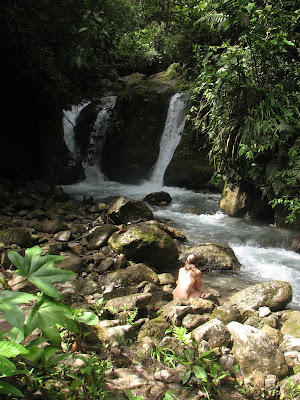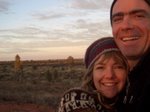So that is where we are up to, arid, warm, northern Perú. I had to make it sound interesting somehow! Truth is that we are pleased to be here. Emily is having a tropical beach holiday, amongst palm trees and out of reach of the Humboldt's sea mists, and I am on a mission to the Equator.
Yep, even as I while away the afternoon in an internet cafe, I am on the way further north. Had planned to get to Quito today, but the silly little men in uniforms stood in my way. I am currently waiting for the bike to get customs-cleared, something which is patently impossible on a Sunday, I am told. There's only one good thing about dealing with officious nincompoops - arguing the point with them! Hehe I always get a laugh out of it!
As far north as I wanted to get - until I found out the real equator is about 200m further north. So I went there and had fun balancing an egg on a nail, watching the Coriolis effect up close, and stuff like that.
Over to you, Em? How are things on the beach? xxxa
Well, despite my facebook boasts of my tropical beach holiday, it's not quite what I expected here ...
Firstly, a comment on the beaches on this side of the world. Apparently Brazil gives us a run for our money, and I've heard they're pretty good Columbia way, but in my opinion, Perú doesn't rate. I'm at Máncora, supposedly one of their finest. The sand is coarse, gritty, and, well ... grey. There are palm trees, sure, but they are all growing at sharp angles, evidently due to the wind that starts up about mid-morning and builds until sunset, making an afternooon trip to the beach an uncomfortably sandy experience. And the waves! The 5 or 6 surf schools are all vying for the beach's one break - which hasn't got much over knee height since I've been here.
Probably the most boring is that since Andy's left, I've become the target of too much latin attention. Which isn't romatic and suave like in the movies, but crude and aggresive, and in this case entirely unwanted.
But then, enough whinging, it's not all bad! I'm staying in a luxurious Indonesian-style bungalow with an amazingly comfy bed, a wonderful hammock, daily fresh sheets and fluffy towels, and - hitherto unheard of in Perù - an endles supply of hot water.
The town has a bit to offer too. There's a lovely vegetarian cafe and somwhere to buy a good coffee. And there's even a breezy internet cafe in which I can finish a couple of job applications I've been working on (yep - it's that time of the trip, probably a great contributor to my grumpiness). And I've managed to have some good conversations too.
However, spending Andy's birthday wihout him, well ... just isn't the real thing.
So now I've had my clothes washed, aired the camping gear, enjoyed the towels and coffee ... and nearly finished my applications, I'm just waiting for my (very Australian, very romantic and very suave) man to come back so I can give him a birthday hug and get back on the adventure!...
Day 4
Well the wind has died down and the sun has come out - and the whole place is filled with colour (even the beach is yellow). I got my job apps in yesterday, and spent the rest of the day soaking up the sun.
Then, only a day after his big one, Andy came back - stoked with his equatorial adventure and to be able to take off his boots off and enjoy the birthday beer and brownie I had waiting for him.
 And we had a mini beach holiday together, lapping up the sun and the sea for all it was worth, before our last hike, 4000km south.
And we had a mini beach holiday together, lapping up the sun and the sea for all it was worth, before our last hike, 4000km south.





















 A world of slow trucks and narrow road later, and the chill evening had us diving into a funny little
A world of slow trucks and narrow road later, and the chill evening had us diving into a funny little  sat on the bridge over the waterfall, discussed campsite, greened out and got scared of the jaguars. A
sat on the bridge over the waterfall, discussed campsite, greened out and got scared of the jaguars. A 










 We crawled and scrambled over these until we were back in the jungle, climbing high above the valley along the edge of another cliff.
We crawled and scrambled over these until we were back in the jungle, climbing high above the valley along the edge of another cliff. Our first close view of the ruins (peering through a gap in the jungle) took our breath away.
Our first close view of the ruins (peering through a gap in the jungle) took our breath away. 




 Aguas Calientes is in a picture perfect location - a valley surrounded by mist-shrouded mountains, on the banks of a raging river. The village itself is a sort of shoddy imitation of a European alps resort - prices included. The three hour walk, last night's rum and yesterday's ride took their toll, and after checking into the first reasonably-priced hostel and asking the proprietor to wake us in half an hour, we promptly crashed out.
Aguas Calientes is in a picture perfect location - a valley surrounded by mist-shrouded mountains, on the banks of a raging river. The village itself is a sort of shoddy imitation of a European alps resort - prices included. The three hour walk, last night's rum and yesterday's ride took their toll, and after checking into the first reasonably-priced hostel and asking the proprietor to wake us in half an hour, we promptly crashed out. Back to the bike. Back to Santa Teresa, a quick and much-needed dip in the local thermal pools. Back to Santa Maria, where we were accosted by the same smarmy 10-year-old. This time he offered us lunch. Andrew told him nicely but firmly that the reason we wouldn't be visiting was because he lied to us two days previously. As we left, I turned to see him quietly sitting in his chair on the verandah, hopefully contemplating the lesson in these words.Back to the start of the asphalt, and this time we were pumping up the tyres, not letting them down, just as the sun was setting.
Back to the bike. Back to Santa Teresa, a quick and much-needed dip in the local thermal pools. Back to Santa Maria, where we were accosted by the same smarmy 10-year-old. This time he offered us lunch. Andrew told him nicely but firmly that the reason we wouldn't be visiting was because he lied to us two days previously. As we left, I turned to see him quietly sitting in his chair on the verandah, hopefully contemplating the lesson in these words.Back to the start of the asphalt, and this time we were pumping up the tyres, not letting them down, just as the sun was setting.






















































